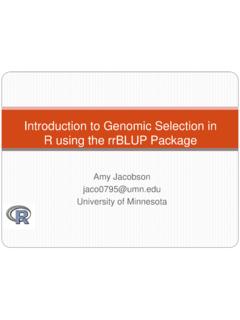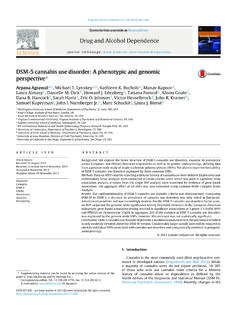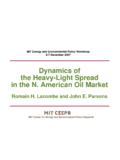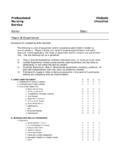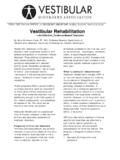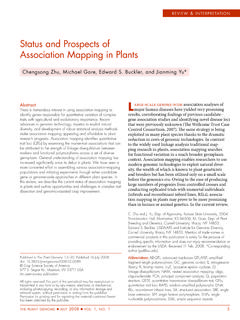Transcription of Introduction to different measures of linkage ...
1 Introduction to different measures of linkage disequilibrium (LD) and their calculation 1 Awais Khan, University of Illinois, Urbana-Champaign By Dr. M. Awais Khan University of Illinois, Urbana-Champaign Awais Khan, University of Illinois, Urbana-Champaign 2 To understand the calculation of linkage disequilibrium consider following example Suppose there are two genes on Chromosome 5 of apple, each with two alleles SNP1 SNP2 Showing only alleles for both SNPs Calculation of linkage disequilibrium Alleles SNP1 SNP2 Allele 1 G A Allele 2 C T Awais Khan, University of Illinois, Urbana-Champaign 3 For better understanding of LD calculation, it is divided into five steps If p1 and p2 =frequency of the alleles at SNP1 and q1 and q2 =frequency of the alleles at SNP2 then in tabular form it could be written as follows Steps in LD calculation Step 1) Calculate allele frequencies SNP1 SNP2 Allele Frequency Allele Frequency G p1 A q1 C p2 T q2 Awais Khan, University of Illinois, Urbana-Champaign 4 Suppose haplotype frequencies are as follows From our example of two SNPs each with two alleles all possible haplotypes are Step 2) Calculate haplotype frequencies SNP2 Allele A T SNP1 G GA GT C CA CT Haplotype Frequency Haplotype Frequency GA p11 GT p12 CA p21 CT q22 Awais Khan, University of Illinois, Urbana-Champaign 5 When haplotype frequencies are equal to the product of their corresponding allele frequencies, it means the loci are in linkage equilibrium Step 3)
2 linkage equilibrium Haplotype frequency Product of allelic frequency p11 = p1q1 p12 = p1q2 p21 = p2q1 p22 = p2q2 Awais Khan, University of Illinois, Urbana-Champaign 6 SNP2 1 2 SNP1 1 p1q1+D p1q2- D p1 2 p2q1- D p2q2+D p2 q1 q2 1 D11=p11- p1q1 D12=p12- p1q2 D21=p21- p2q1 D22=p22- p2q2 We can deduce linkage disequilibrium for each haplotype as the deviation of observed haplotype frequency from its corresponding allelic frequencies expected under equilibrium Step 4) linkage disequilibrium After solving above for D, we get as follows: Awais Khan, University of Illinois, Urbana-Champaign 7 p11 p22 =(p1 q1 + D )(p2 q2 + D ) = p1q1p2q2+ p1q1D + p2q2D + D2 p12 p21 = (p1 q2 D )(p2 q1 D ) = p1q1p2q2 p2q1D p1q2D + D2 Subtracting (p1q1p2q2+ p1q1D + p2q2D + D2) (p1q1p2q2 p2q1D p1q2D + D2) p11 p22 p12 p21 = D (p1 q1 + p2 q1 + p2 q2 + p1 q2 ) = D (1) = D Commonly used measure of linkage disequilibrium , D equals to p11 p22 p12 p21 and we can prove it by solving the four equations from previous slide Step 5) Calculation of linkage disequilibrium measure D a) b) c) Awais Khan, University of Illinois, Urbana-Champaign 8 P11 = p1q1= x = P22 = p2q2= x = P12 = p1q2= x = P21 = p2q1= x = D = (P11)(P22) -(P12)(P21) D = ( ) ( ) - ( ) ( )
3 = 0 Estimate of D in case of linkage Equilibrium If allele frequencies of p1 and q1 are both and equilibrium occurs (only Ab and aB exist in the population) Awais Khan, University of Illinois, Urbana-Champaign 9 P11 = p1q1+ D = + D = P22 = p2q2+ D = + D = P12 = p1q2-D = -D = 0 P21 = p2q1-D = -D = 0 D = (P11)(P22) -(P12)(P21) D = ( ) ( ) - (0) (0) = Estimate of D in case of linkage disequilibrium If allele frequency of p1 and q1 are both and there is complete non-random association (only AB and ab exist in the population) with equal allele frequencies at all loci Awais Khan, University of Illinois, Urbana-Champaign 10 Sometimes, depending on allele frequency of two loci, the value of D can be negative, but actual gametic frequencies cannot be negative To overcome this issue, standardization methods have been proposed Standardization of D Awais Khan, University of Illinois, Urbana-Champaign 11 In a common standardization method, a relative measure of disequilibrium (D) compared to its maximum is used.
4 D = D / Dmax When D is positive Dmax= min [ (p1q2) or (p2q1) ] When D is negative Dmax= min [ (p1q1) or (p2q2) ] This standardization makes D-values range between 0 and 1 Standardization of D Awais Khan, University of Illinois, Urbana-Champaign 12 Another commonly used measure to calculate LD between loci is Pearson coefficient of correlation (r) r = D/ (p1p2q1q2)1/2 However, squared coefficient of correlation (r2) is often used to remove the arbitrary sign introduced Correlation coefficient as a measure of LD Awais Khan, University of Illinois, Urbana-Champaign 13 However, r can be conveniently used for chi-test, as 2 = r 2 N where N is the number of chromosomes in the sample To test if LD is statistically significant we can do a 2 test 2= (obs-exp)2/ exp expected is random associations between alleles Testing significance of LD Awais Khan, University of Illinois, Urbana-Champaign 14 Genotypic data GA = 474 GT = 611 CA = 142 CT = 773 Total = 2000 Haplotype Frequencies GA = 474 / 2000 =.
5 2370 GT = 611 / 2000 = .3055 CA = 142 / 2000 = .0710 CT = 773 / 2000 = .3865 Example Let s assume that we have genotypic data for the two SNPs with two alleles each (same example used to deduce the equations for different LD measures ) Calculation of haplotype and allele frequencies Allele frequencies G = C = A = T = Awais Khan, University of Illinois, Urbana-Champaign 15 D = (P11 P22) - (P12 P21) D = ( x ) - ( x ) = Input values in the equation for D to calculate linkage disequilibrium To estimate Dmax input allelic frequencies and value for D in the following equation Dmax = min [ (p1q2) or (p2q1) ] Dmax = ( x ) = or = ( x ) = Awais Khan, University of Illinois, Urbana-Champaign 16 Now calculate D input value of D and Dmax calculated in previous step in the following equation D = D / Dmax D = / = = To calculate coefficient of correlation (r)
6 , input value of D and allele frequencies calculated in previous steps in the following equation r = D / (p1p2q1q2) r = /( x x x )1/2 r = / = r2 = ( )2 = 0 .092 Awais Khan, University of Illinois, Urbana-Champaign 17 2 = r 2 N 2 = x 2000 = (1 df) At and df of 1, P-value is So, we can conclude based on our calculations that there is a significant LD between loci and it is 50% of the theoretical maximum Also note that two SNPs are in complete LD (not separated by recombination) when D ' = 1 or r2=1 To check the significance of LD between loci use following equation Awais Khan, University of Illinois, Urbana-Champaign 18 Reference: Lewontin 1988. On measures of Gametic disequilibrium . Genetics, 120(3):849-852. Devlin B., Risch N. 1995. A Comparison of linkage disequilibrium measures for Fine-Scale Mapping. Genomics 29 (2): 311-322.




